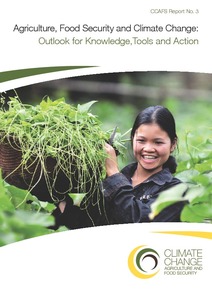Agricultural practices and technologies to enhance food security, resilience and productivity in a sustainable manner: Messages to the SBSTA 44 agriculture workshops
This paper synthesizes knowledge within CGIAR and its partners on agricultural practices and technologies to enhance food security, resilience and productivity in a sustainable manner. A number of agricultural practices and technologies which contribute to these objectives were identified and assessed to generate four key lessons.
Agriculture in the rural-urban continuum: a CGIAR research perspective
Thirsty and hungry cities are posing significant challenges for the urban-rural interface ranging from food security to inter-sectoral water allocation. Not only is the supply of resources to urban centres a growing challenge in low-income countries, but even more is the urban return flow, as investments in waste management and sanitation, ie the ‘ultimate food waste’, are not able to keep pace with population growth. And where polluted water is used in irrigation to feed the cities, food safety is becoming a crucial component of food security.
Adjustment and Sensitivity Analyses of a Beta Global Rangeland Model
G-Range is a global model that simulates generalized changes in rangelands through time,
created with support from the International Livestock Research Institute. Spatial data and a set
of parameters that control plant growth and other ecological attributes in landscape units
combine with computer code to represent ecological process such as soil nutrient and water
dynamics, vegetation growth, fire, and wild and domestic animal offtake. The model is spatial,
with areas of the world divided into square cells.
Agriculture, food security and climate change: Outlook for knowledge, tools and action
Agriculture and food security are key sectors for intervention under climate change. Agricultural production is highly vulnerable even to 2C (lowend) predictions for global mean temperatures in 2100, with major implications for rural poverty and for both rural and urban food security. Agriculture also presents untapped opportunities for mitigation, given the large land area under crops and rangeland, and the additional mitigation potential of aquaculture.
African Livestock Futures: Realizing the potential of livestock for food security, poverty reduction and the environment in Sub-Saharan Africa
African urban harvest: Agriculture in the cities of Cameroon, Kenya and Uganda.
Agricultural Adaptation and Institutional Responses to Climate Change Vulnerability in Ethiopia
Climate change is a major development challenge to Ethiopia. Climate change is expected to
adversely affect all economic sectors, eco-regions, and social groups. Agriculture is one of the
most vulnerable sectors as it is highly dependent on rainfall. This report synthesises four case
studies focusing on the impacts, vulnerabilities and local adaptation practices in Ethiopia‘s
agricultural sector, including policy and institutional responses. The case studies were carried
An integrated agro-ecosystem and livelihood systems approach for the poor and vulnerable in dry areas
More than 400 million people in the developing world depend on dryland agriculture for their livelihoods. Dryland agriculture involves a complex combination of productive components: staple crops, vegetables, livestock, trees and fish interacting principally with rangeland, cultivated areas and watercourses. Managing risk and enhancing productivity through diversification and sustainable intensification is critical to securing and improving rural livelihoods.
An Overview of Dairy Cattle Models for Predicting Milk Production: Their Evolution, Evaluation, and Application for the Agricultural Model Intercomparison and Improvement Project (AgMIP) for Livestock.
The contemporary concern about anthropogenic release of greenhouse gas (GHG) into the
environment and the contribution of livestock to this phenomenon have sparked animal
scientists’ interest in predicting methane (CH4) emissions by ruminants. Focusing on milk
production, we address six basic nutrition models or feeding standards (mostly empirical
systems) and five complex nutrition models (mostly mechanistic systems), describe their key
characteristics, and highlight their similarities and differences. Four models were selected to
Annual Report 2011: Groundwork for success
2011 was the first year of operation of the CGIAR Research Program on Climate Change, Agriculture and Food Security (CCAFS). CCAFS brings together the work of all 15 international Centres in the CGIAR, and is a joint programme between the CGIAR and the Earth System Science Partnership (ESSP). 2011 was a start-up year in terms of introducing a new way of working across Centres, but it was also a year of considerable research effort. Work was initiated in the field at many sites, and baseline surveys were completed in three regions on two continents.












